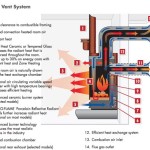Outdoor Fireplace Chimney: A Guide to Safe and Efficient Installation
An outdoor fireplace adds a touch of warmth, ambiance, and functionality to any outdoor space. However, the safety and efficiency of an outdoor fireplace largely depend on the chimney. An outdoor fireplace chimney serves a crucial role in safely venting smoke and gasses, preventing potential dangers and ensuring optimal fireplace performance. Understanding the different types of outdoor fireplace chimneys, their installation considerations, and maintenance practices is essential for homeowners looking to enjoy their outdoor fireplace safely and effectively.
Types of Outdoor Fireplace Chimneys
Outdoor fireplace chimneys are available in various materials, each with its own advantages and disadvantages. The most common types include:
- Brick Chimneys: Durable and aesthetically pleasing, brick chimneys offer excellent heat resistance and longevity. However, they can be expensive and require skilled labor for installation.
- Metal Chimneys: Typically made of stainless steel or galvanized steel, metal chimneys are lightweight, corrosion-resistant, and relatively easy to install. They come in various styles and sizes to suit different outdoor fireplaces.
- Pre-Fabricated Chimneys: Pre-fabricated chimneys consist of individual sections that are assembled on-site. These chimneys are often made of metal and are designed for ease of installation. They offer a cost-effective alternative to traditional brick chimneys.
Installation Considerations
Installing an outdoor fireplace chimney requires careful planning and attention to detail. Some key considerations include:
- Height and Location: The chimney should be tall enough to ensure proper draft and prevent smoke from entering the surrounding area. It should also be located in a safe area, away from any flammable materials.
- Fireplace Type: Different fireplace designs require specific chimney configurations. Consult with a qualified installer to ensure compatibility between the fireplace and the chimney.
- Building Codes: Local building codes may have specific regulations regarding outdoor fireplace chimneys, such as minimum height requirements and fire safety standards.
- Chimney Liner: Installing a chimney liner is highly recommended, especially for metal chimneys. A liner protects the chimney from excessive heat and potential corrosion, ensuring safe and efficient smoke venting.
Maintenance and Safety
Regular maintenance is crucial for the longevity and safety of an outdoor fireplace chimney. Here are some essential maintenance practices:
- Annual Inspection: Inspect the chimney annually for any cracks, leaks, or blockages. Look for signs of soot buildup, bird nests, or other debris that can hinder proper draft.
- Chimney Sweeping: Hire a professional chimney sweep to clean the chimney regularly, typically once or twice a year depending on usage. Sweeping removes soot and creosote buildup, reducing the risk of chimney fires.
- Fireplace Usage: Use only dry, seasoned wood in your fireplace. Avoid burning trash, plastics, or other materials that can release harmful fumes or cause chimney damage.
By understanding the different types of outdoor fireplace chimneys and following proper installation and maintenance practices, homeowners can enjoy the warmth and ambiance of an outdoor fireplace safely and effectively. Remember to consult with a qualified installer to ensure that your chimney is properly installed and meets all local building codes.

Outdoor Fireplaces Round Grove S

Outdoor Fireplace Kits Stonewood S Cape Cod Ma Nh Ct

Outdoor Stone Paver Firepits Fireplaces Installer Minneapolis St Paul

Saguaro Diy Outdoor Fireplace Plan

Diy Outdoor Fireplace Ideas

Outdoor Fireplace Kits Masonry Stone

Outdoor Fireplaces Garden Fires For Bonfire

Outdoor Rumfords

Five Fabulous Outdoor Fireplace Ideas Coogans Landscape Design

How To Build An Outdoor Fireplace Firefarm Living








